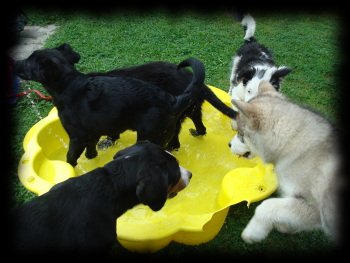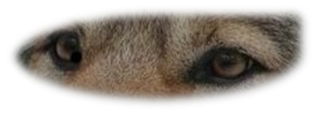Dog
Classification of the dog

History of the origins of the dogs is fascinating but the facts till today are still of speculative kind. Dogs are mentioned in the group of carnivors, a subgroup of the mammals. Carnivors usually are split into eight families: Canides (Dogs), Procyonids (Racoons), Felides (Cats), Mutelids (Weasel), Ailurids (Pandas), Ursids (Bears), Viverrids (little Wildcats) and the Hyanids (Hyenas). Housedogs belong to the Canids. Canids usually are split into four groups: Dogs (genus Canis), Foxes (genus Vulpes), Culpeo (genus Dysicyon) and Bushdogs (all other genera).
The group of the Bushdogs includes the Bushdog, the plant eating Fox, the Racoondog and the Greyfox, while the group of Foxes covers almost all kind of foxes, except the Greyfox and a few others.
The Culpeo-Group includes species, which lie between dog and fox like the Falkland wolf, the Culpeo fox, the striped tail dog, the Andes wolf and the manewolf.
Within the group of dogs, the Dhole, the afrikan Wilddog and the Canids are represented. The first two genera only include the Dholes and the afrikan wilddogs, the Canisgroup contains the Coyote, the Jackal, the Wolf, the Dingo and the Housedog.
All species in the Canisgroup have the same structure of the sceleton inclusive the five toes in the fore paw and four of them in the back paw, as well as a round Iris which contracts.
These characteristics, which the housedog has same with this group, are a mark for the fact that his ancestors might be found there.
Prehistoric roots
The members of the gender canis emerged before approximately 1 million years, first in Asia or Eurasia. Later they walked between these continents back and forth. They also appeared in America, mainly in the northern territories. At this time, Eurasia and America were not separated continents. As there have not yet been found some fossils in Australia we believe that dogs only developed after the continental division.
As we believe, that the very oldest fossil of a dog found (found in Yorkshire, England) is dated out within the Mesolythicum, we think,that human kind about 500'000 years before - so in the Palaeolythicum - did not yet build some relationship to dogs. Many of the early breeds developed to their todays form in fitting to their environment. From Breeds with the old bloodlines, which look like wolfs or jackals, it is told, that they are less aggressive than wolves, because they were scavengers and lived from the rests of other carnivors and animals.
Wilddogs and Housedogs
Dogs resemble wolves more than any other animal. Wolves are spread mainly in the northern hemisphere: in Europe, North America and Asia. Usually those living in a colder climazone have a more bright color (most probably as protection) and are more aggressive, while those, living in warmer regions are smaller and have a yellowish deer color which is more bright to the belly and are less aggressive. This color is also most frequent with house dogs. Although one often believes that wolves are enemies of human kind, the contrary is rather correct; they attack very rarely people but get used rather quickly to them. Jackals often hunt in groups, although they survive mainly by carrion which is left by other carnivores. The coyote with his snout, the big ears and the thick tail look very similar to the wolf. He lives to the Grass plains in North America, that is why he is also named the grass plain wolf. His number has decreased drastically, caused by the misled efforts of human kind to exterminate him to protect their stocks of animals. In South America there are wild dogs, as for example to the plants eating wolf and the Zorro. Zorros have big ears, thick tails and stocky bodies. The breeding of crossings between these wild dogs and the house dogs was high estimated by the people resident there because of their hunting abilities. The Australian wild dog is the Dingo which barks only rarely in the wilderness but starts, however, immediately with it if he is tamed.
All above mentioned dogs are members of the so named dog's group and, therefore, are respected as relatives of the house dog known today. From the appearance, their habits and their mode of expression they are similar to themselves all completely. Although there are some exceptions, as for example bulldogs with short snouts, dwarf's chihuahuas, English setter and spaniel with hanging ears, they all have usually their common characteristic features. These contain the kind and number of the teeth (41); the skull form, although the size is different; the total number (50 - 52) and the sort of the vertebras: 7 cervical vertebras, 13 dorsal vertebras, 7 lumbar vertebras, 3 sacrum vertebras and 20 - 22 tail vertrebras; an Iris which contracts circularly; a good sense of smelling, wheras the prey is searched by the smell; similar physical sufferings and diseases like distemper, rabies and heart worms; the sort to howl to growl and to express pain; the way to show joy (put on ears and wave the tail), rage (placed hair and shown teeth) and submission (laying on the back and / or pinch the tail); nocturnal habits; an tendency to dig; a 9-week pregnancy and the opening of the eyes at the age of 2 weeks.
In spite of such similar characteristic features it is respected as dangerous to cross house dogs and dogs from the group the Canis familiaris with each other. Certainly, the offspring can reproduce itself, but does not only have a strange exterior appearance, but turns often also out as shy. The rest sorts of wild dogs are rather unimportant for the current house dogs.
Human and dog
People from the prehistoric time which more or less did not knew clothes, must have had very cold in hunting animals like mammoth, game and buffalos with in the hand carried weapons. They also caught fish and shellfishs from the rivers and in the seashores, looked for roots and picked fruits and edible plants. At this time most probably the people competed with wild dogs for food and most probably also did eat them. Later, when the people formed tribes and went in caves, they began to establish separated areas and guarded them. While human hunters usually dominated over dog's herd, both creatures most probably began to become clear to themselves about the mutual advantages of a relation: rests of carrion were where people settled, and dog's herds barked if unknown people or other animals approached. Because the dogs always got closer to the settlements of the people, the people likely began with attempts to tame them. We know that in north-west Europe during the Mesolythicums, also approximately 12 ' 000 years ago, people started with the keeping of pets.
During the Neolythicums, people departed out of the caves and established the first settlements with thatched huts near by water. They were busy with agriculture and the breeding of sheep. An entire fossil of a dog who neither had been killed nor had been eaten, was found in a European settlement from this time. One believes that it was a tamed dog. Substantially laid out bones of dogs on neolythical churchyards which were recently dug out in Europe, show that dogs were already high estimated at this time by the people.
From the moment by which the people recognized that tamed dogs could be useful and since they began to catch wild puppies, the choice of desired body characteristic features and behavioural characteristic features began to adapt the dogs to certain tasks.
Over many centuries changes executed by people resulted in a big number of different breeds with different characteristic features. However, one has remained to all breeds known to us - the behavior similar to wolf, some more distinct, some other less.
Classification of the dog
Today, approximately 350 breeds are accepted by the Fédération Cynologique Internationiale (FCI) which has its head office in Belgium (Brussels). If, however, one considers that a whole number of national breeding groups are still no members of the FCI, the total number of recognizable races likely reaches 500. Every fixed race has an official sentence of standards which indicates the astonishing degree up to which the originally wild dogs were changed to produce the big variety which we know today. Usually the standards, as set up by the respective recognized family club of the concerning breed and wich are used to judge this kind of dogs, usually contain the history and pedigree, their use, their general appearance, their temperament, their build (head, body, tail, limbs, fur, color, ...), their way to walk, their size and their lack.
As per FCI following breeds are known and accepted:
| ||||||||||||||||||||||||||||||||||||||||||||||||||||||||||||||||||||||||||
© Alaskan-Malamute.ch



